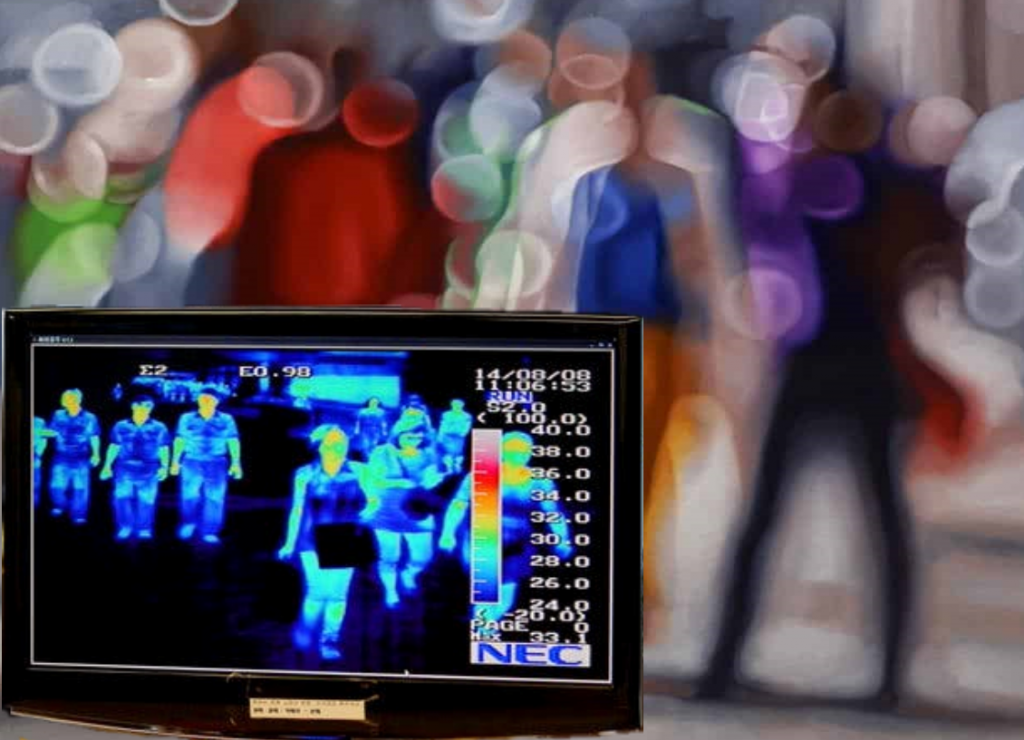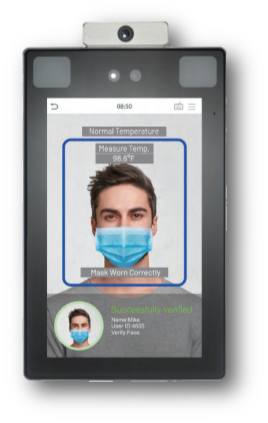The Pros and Cons of Thermal Cameras That Measure a Person’s Temperature
Thermal imaging cameras have been around for many years. They were first used in the 1940s and 1950s by the military. Long-range camera systems use thermal cameras to help with detection, recognition, and identification (DRI) of targets. They have also been used in previous pandemics.
Today, thermal imaging cameras have become popular because of the outbreak of COVID-19.
Some of the older thermal cameras have been repurposed to measure a person’s temperature from a distance. The latest systems are designed for measuring people’s body temperature and have been integrated with door access control.

This article reviews the various technologies and how they can help monitor people as they enter a secure area.
How Thermal Cameras Work?
A thermal imaging camera captures the thermal energy emanating from an object. The camera is similar to the optical (or visual) camera that captures visible light. Instead of seeing the visible spectrum, the thermal camera captures the longer-wavelength infrared portion of the electromagnetic spectrum.

There is a difference in the display from the visual and the thermal camera. The optical camera displays a color image representing what the human eye can see while the thermal camera provides a composite of the thermal energy from a range of frequencies. The thermal camera shows the temperature gradient of the scene. There are two types of thermal displays. One type differentiates the temperature of the video using a gray-scale while the other type provides a color representation. The grey-scale camera displays a lighter gray color for the hotter part of the image. The color thermal cameras create false-color images to represent the heat from the object. It assigns a shade of a color to the temperature gradient that they detect. Colder temperatures are often given a shade of blue, purple, or green, while warmer temperatures can be assigned a shade of red, orange, or yellow.
The new temperature measuring camera systems provide special capability. They include face detection logic that allows them to measure the heat from the forehead or eyes.
Door Access and Temperature Monitoring
Temperature screening systems can operate by themselves or as part of an access control system. The simple systems just monitor an area where people can enter, and if they detect elevated temperatures, they will provide an audio warning. They don’t control a door.
The new thermal measuring systems are integrated into an access control door system. Not only do they measure the person’s temperature, but they also can determine if a person is wearing a mask and if they have the right biometric credentials to enter the area. The advanced panels combine optical (visual) and thermal cameras. They display the optical camera video and provide an overlay of the temperature that the thermal camera has measured. For example, see the TVIP-MultiBio reader-controller.

Not only do the panels integrate with door access control, but they also provide immediate notification of unacceptable conditions. These temperature measuring panels provide an audio announcement that notifies the person at the door that they can enter or that they have elevated temperature (or, in some cases, not wearing a mask).
How Temperature Monitoring Can Help
The first wide-spread use of thermal cameras to screen people began in China. With billions of people to test, it was necessary to find an easy way to limit the spread of infection. Thermal camera systems have been used in crowded areas such as railway stations, airports, subways, and even hospitals. They have helped to ensure that these areas don’t become breeding spots for carriers.
These temperature monitoring camera systems help to detect if a person has an elevated temperature and doesn’t indicate that they have any specific disease. Fever is only one of the symptoms of the COVID-19 virus, but it is undoubtedly one of the easiest and unobtrusive ways to screen lots of people.
Even though the best way to reduce the spread of CORONA-19 is to provide diagnostic testing, the thermal temperature screening method is an acceptable alternative. The FDA provided the following guidance in their document, Enforcement Policy for Telethermographic Systems During the Coronavirus Disease 2019 (COVID-19) Public Health Emergency. It states that, “To help ensure the availability of products that might offer benefit to health care providers and the general public during the public health emergency, FDA does not intend to object to the distribution and use of telethermographic systems intended for initial body temperature assessment for triage use…”
How to Achieve the Best Performance from Your Temperature monitoring System
To make your system as reliable as possible, here are some things to consider:
- The temperature measuring device should be used in a room with a room temperature between 10 C -40C
- Do not install the temperature measuring device under a heating or cooling vent, and ensure that there is no heating source within 3 meters.
- Personnel entering the room from a cold outdoor environment will affect the measurement accuracy, so allow some time for the person’s overall temperature to stabilize.
- The forehead should be unobstructed for three minutes, and the temperature should be allowed to stabilize to get the best temperature reading,
- The best temperature is measured from the forehead, so make sure no hair or clothing is covering this area.
- Note that when there is water, sweat, oil, or thick makeup on the forehead or the elderly have more wrinkles, the temperature can be lower than the actual temperature
Summary
The pandemic has closed many businesses. Many locations around the country are looking for ways to reopen their businesses. They are searching for ways to make the business as safe as possible. Temperature monitoring solutions provide one line of defense by scanning the people as they enter the area. Some thermal temperature devices provide just audio notification of elevated temperature, while others are integrated with access control systems. Some systems offer face recognition as well as palm biometric reading, while other models only use face-recognition for door entry control.
For help selecting the right temperature scanning system, please contact us at 800-431-1658 in the USA, or 914-944-3425 everywhere else, or use our contact form.